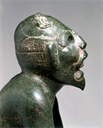Description
This object is among the most remarkable Olmec sculptures, portraying a marvelously strange blend of human and jaguar physiognomy. Although possessing human ears, a pair of jaguar ears also sprouts from the head. Moreover, just below the human nose, there is the snarling, toothy maw of the jaguar, open as if emitting a powerful roar. Although slightly more subtle, the muscular, compact body reveals the same merging of man and feline. While primarily human, the forearms adopt the rearing stance often found among Olmec jaguars. In addition, the hands are tightly curled into fists, as if becoming feline paws.
Fashioned of hard and opaque green stone, the sculpture is relatively well preserved, with only minor damage to the head. In addition to a slightly chipped right ear, the upper canines also appear to be broken. Aside from the region of the loins, the surface is well polished, with the entire piece subsequently painted with a red cinnabar pigment. On the body, the primary emphasis lies in the subtle portrayal of musculature, with fine line incision being reserved only for the nails of the thumb and large toe. In contrast, a great deal of incision is used on the head, to delineate facial features as well as hair. The nostrils were created by drilling, with a pair of joined holes piercing the septum. The eye orbits were also fashioned by drilling, although in this case large, hollow-core drills appear to have been employed. Although now missing, the eyes were probably of inlay.
Authors have noted that the widespread merging of human and jaguar traits in Olmec art frequently concerns the shamanic concept of transformation, that is, the metamorphosis of the shaman into his or her supernatural counterpart. These sculptures may represent shamans engaged in visionary trances, perhaps induced by powerful hallucinogens.
Bibliography
1993. In National Geographic. vol. 184. p. 96.
Benson, Elizabeth P. 1981 Some Olmec Objects in the Robert Woods Bliss Collection at Dumbarton Oaks. In The Olmec and Their Neighbors: Essays in Memory of Matthew W. Stirling, Matthew Williams Stirling, Michael D. Coe, David C. Grove and Elizabeth P. Benson, eds., pp. 95-108. Dumbarton Oaks Research Library and Collections, Trustees for Harvard University, Washington, D.C.
Benson, Elizabeth P. and Beatriz de la Fuente (EDS.) 1996 Olmec Art of Ancient Mexico. National Gallery of Art, Washington, D.C.
Coe, Michael D. 1996 The Olmec World: Ritual and Rulership. Art Museum, Princeton University, Princeton, N.J., p. 73, 170, fig. 1, 8.
Darlington, Robert and John Hospodaryk 2012 History Alive, for the Australian Curriculum. John Wiley & Sons, Queenland, Australia. p. 42.
Easby, Elizabeth Kennedy and John Frederik Scott 1970 Before Cortés: Sculpture of Middle America (a Centennial Exhibition at the Metropolitan Museum of Art from September 30, 1970 through January 3, 1971). Metropolitan Museum of Art, New York.
Evans, Susan Toby 2004 Ancient Mexico & Central America: Archaeology and Culture History. Thames & Hudson, New York.
González Calderón, O. L. 1991 The Jade Lords. O.L. González Calderón, Coatzacoalcos, Ver., pl. 227.
Goodman, Felicitas D. 1988 Ecstasy, Ritual and Alternate Reality: Religion in a Pluralistic World. Indiana University Press, Bloomington. p. 21.
Gutiérrez Mendoza, Gerardo and Mary E. Pye 2010 Iconography of the Nahual: Human-Animal Transformations in Preclassic Guerrero and Morelos. In The Place of Stone Monuments: Context, Use, and Meaning in Mesoamerica's Preclassic Transition, Julia Guernsey, John E. Clark and Bárbara Arroyo, eds., pp. 27-54. Dumbarton Oaks Pre-Columbian Symposia and Colloquia, Joanne Pillsbury, general editor. Dumbarton Oaks Research Library and Collection, Washington, D.C., p. 28, fig. 2.1(a).
Headrick, Annabeth 2007 The Teotihuacan Trinity: The Sociopolitical Structure of an Ancient Mesoamerican City. University of Texas Press, Austin.
Magni, Caterina 2003 Les Olmèques: Des Origines Au Mythe. Seuil, Paris.
Reilly, Frank Kent, III 1989 The Shaman in Transformation Pose: A Study of the Theme of Rulership in Olmec Art. Record of the Art Museum, Princeton University 48 (2):4-21. p. 11-13.
Saunders, Nicholas J. 1998 Icons of Power: Feline Symbolism in the Americas. Routledge, London; New York. p. 18.
Sobchack, Vivian C. 2000 Meta-Morphing: Visual Transformation and the Culture of Quick-Change. University of Minnesota Press, Minneapolis. p. 40, fig. 3.1.
Stuart, George E. 1993 New Light on the Olmec. National Geographic 184 (5).
Stuart, George E. 2001 Ancient Pioneers: The First Americans. National Geographic Society, Washington, D.C. p. 125.
Stuart, George E. 2003 Die Olmeken in Neuem Licht. National Geographic Spezial, Deutschland März 2003:154-173.
Taube, Karl A. 2004 Olmec Art at Dumbarton Oaks. Pre-Columbian Art at Dumbarton Oaks; No. 2. Dumbarton Oaks Research Library and Collection, Washington, D.C., p. 59, pl. 5.
Related:
Bernal, Ignacio 1967 Museo Nacional De Antropología De México; Arqueología. Librofilm Aguilar. Aguilar, México. fig. 188.
Easby, Elizabeth Kennedy 1966 Ancient Art of Latin America from the Collection of Jay C. Leff. Brooklyn Museum, New York.
Furst, Peter T. [between 1968 and 1978] The Olmec Were-Jaguar Motif in the Light of Ethnographic Reality. p. 143-178.
Von Winning, Hasso and Alfred Stendahl 1968 Pre-Columbian Art of Mexico and Central America. H.N. Abrams, New York.
Acquisition History
Formerly in the collection of Ferdinand Ries, Frankfurt, 1928
Purchased by John Hauberg for the collection of Mr. and Mrs. John H. Hauberg, Seattle.
Purchased from John H. Hauberg, Seatle, by Dumbarton Oaks,1977.
Dumbarton Oaks Research Library and Collection, Pre-Columbian Collection, Washington, DC.






